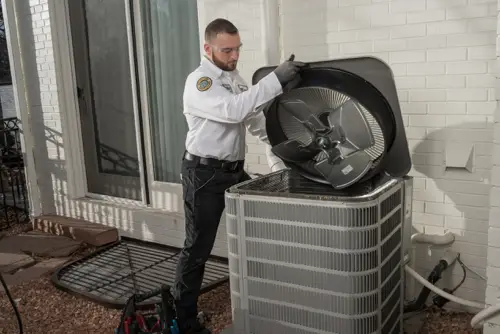 There’s nothing worse than turning on your air conditioner on a hot day only to find that it’s blowing hot air. It’s literally the opposite of what it’s supposed to be doing, and it should be fixed right away. We at One Hour Air Conditioning & Heating can take a look at your air conditioner to find out what’s wrong with it, but it still helps to know why it might blow hot air throughout your home.
There’s nothing worse than turning on your air conditioner on a hot day only to find that it’s blowing hot air. It’s literally the opposite of what it’s supposed to be doing, and it should be fixed right away. We at One Hour Air Conditioning & Heating can take a look at your air conditioner to find out what’s wrong with it, but it still helps to know why it might blow hot air throughout your home.
Thermostat Issues
If your air conditioner isn’t cooling your home as quickly as it should, check your thermostat before you do anything else. It’s entirely possible that your thermostat is set at the wrong temperature, or it might even be on the “Heat” setting. Even having your home’s fan on can offset the temperature coming from your vents and make it feel like your AC isn’t working.
If you determine that your problems aren’t due to human error, something might be wrong with your thermostat. It may need to be calibrated, which should be done once a year. It might also need new batteries, especially if its display isn’t working properly.
A Tripped Circuit Breaker
In most cases, a tripped circuit breaker will prevent your AC unit from working at all. However, some HVAC systems have individual components that run on their own circuits. For example, your outdoor condenser unit might lose power even when the rest of your HVAC system is still working properly. If this happens, your HVAC system will blow hot air no matter how you adjust your thermostat.
If your air conditioner isn’t working or you lose power elsewhere in your home, check your circuit breaker box. It’s usually found in your garage, basement, or utility room. If it looks like any breakers have been tripped, reset them and wait a few minutes to see if that fixes your AC problems.
A Clogged Water Line
Your air conditioner produces water that is removed from your home by a drain system. Many air conditioner systems have a safety mechanism that shuts down the compressor if too much water builds up, which can happen if the drain line is clogged. An HVAC technician can clear the line and make sure it stays in good working condition during your regular AC tune-up.
A Dirty Air Filter
Your HVAC system has a filter that removes dust, pollen, dander, and other pollutants from the air in your home. Naturally, it gets quite dirty and needs to be cleaned or replaced regularly. It can restrict the airflow through your home’s ducts when it gets dirty, and it can even cause your system to shut down in extreme cases. It can also affect your system’s evaporator coil. A dirty evaporator coil won’t allow your home to cool properly, which can result in warm air blowing through your vents.
Low Refrigerant Levels
Refrigerant cools the air as it blows through your home’s ducts, and it can slowly leak from your HVAC system. When it gets low enough, your air conditioner won’t be able to cool your home. An HVAC technician can inspect your refrigerant levels and replenish them if necessary, so contact us if you suspect that this is a problem in your home.
A Malfunctioning Compressor
Your AC’s compressor compresses the refrigerant that keeps your evaporator coil cold. As warm air passes over the coil, it’s cooled and distributed throughout your home. If your compressor isn’t working properly, it can’t keep the evaporator coil cold enough to keep your house cool.
The condenser is usually found in your outdoor AC unit, which can get quite dirty over time. This is probably the most common reason why it might not work properly. You can help prevent problems by keeping a close eye on your outdoor AC unit and keeping it free of debris.
These are some of the things that can cause your air conditioner to blow warm air. In any case, warm air is always a sign that something is wrong with your air conditioner. If this is happening to you and you can’t find the cause yourself, contact One Hour Air Conditioning & Heating for assistance. We’ll be happy to take a look at your HVAC system and get to the bottom of the issue.